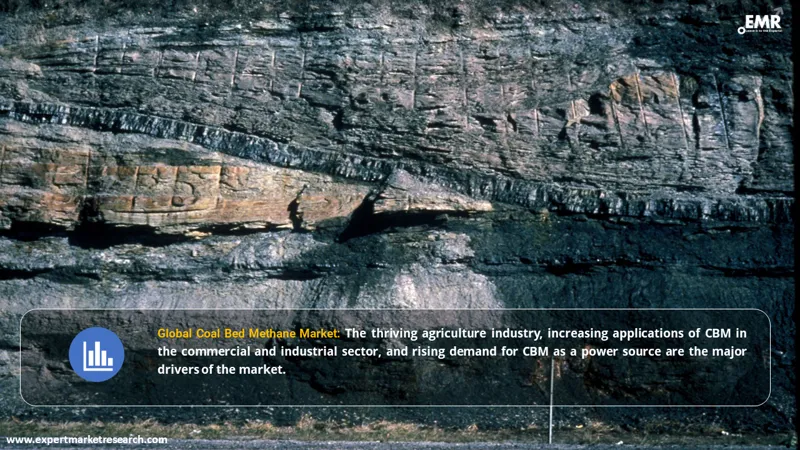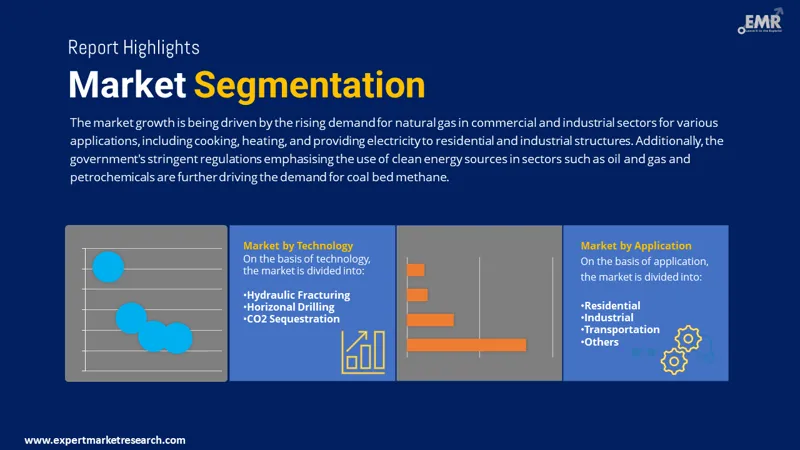
Consumer Insights
Uncover trends and behaviors shaping consumer choices today
Procurement Insights
Optimize your sourcing strategy with key market data
Industry Stats
Stay ahead with the latest trends and market analysis.
The global coal bed methane market size stood at a value of around USD 19.22 Billion in 2025. The market is further expected to grow in the forecast period of 2026-2035 at a CAGR of 6.30% to reach USD 35.41 Billion by 2035.
Base Year
Historical Period
Forecast Period
Compound Annual Growth Rate
6.3%
Value in USD Billion
2026-2035
*this image is indicative*
| Global Coal Bed Methane Market Report Summary | Description | Value |
| Base Year | USD Billion | 2025 |
| Historical Period | USD Billion | 2019-2025 |
| Forecast Period | USD Billion | 2026-2035 |
| Market Size 2025 | USD Billion | 19.22 |
| Market Size 2035 | USD Billion | 35.41 |
| CAGR 2019-2025 | Percentage | XX% |
| CAGR 2026-2035 | Percentage | 6.30% |
| CAGR 2026-2035 - Market by Region | Middle East and Africa | 6.7% |
| CAGR 2026-2035 - Market by Country | India | 7.9% |
| CAGR 2026-2035 - Market by Country | China | 6.8% |
| CAGR 2026-2035 - Market by Technology | CO₂ Sequestration | 7.1% |
| CAGR 2026-2035 - Market by Application | Industrial | 7.3% |
| Market Share by Country 2025 | Japan | 5.1% |
Hydraulic fractioning technique is witnessing a rise in application in the oil and gas sector to improve the efficiency of coal bed methane walls, which is driving the segment’s growth. In addition to this, the technique also increases the production output while having no effect on drinking water owing to the horizontal propagation of the fracs.

Read more about this report - REQUEST FREE SAMPLE COPY IN PDF
Meanwhile, the horizontal drilling segment is likely to gain traction in the forecast period in coal bed reservoirs which is further propelling the market growth. During the forecast years, increased research and development activities to understand the pattern of drilling, for a better understanding of gas content, permeability, and characteristics of desorption, are likely to provide impetus to the segment.
The coal bed methane market in the region is being driven by the favourable policies of governments encouraging the acceptance of CBM as a source to produce various downstream products. For instance, in India, a license was issued to automotive manufacturing companies to use CBM as a primary fuel to run automotive vehicles.
Europe is anticipated to witness a steady growth in the coming years owing to the strong foothold of major CBM manufacturing companies planning to increase their production capacities.
Coal bed methane, also known as marsh gas, is a natural gas in unconventional form of natural gas which is obtained from coal deposits and coal seams. It is procured through a process in which plant material is transformed into coal, known as coalification. It is widely used as an active energy source in various industries.
Market Breakup by Technology
Market Breakup by Application
Market Breakup by Region

Read more about this report - REQUEST FREE SAMPLE COPY IN PDF
Coal bed methane is used as a clean energy source to produce natural gas. The increasing demand for natural gas in commercial and industrial sectors for applications such as cooking, heating, and providing electricity to residential and industrial structures, among others, is driving market growth. Stringent regulations of the government emphasising on utilising clean energy sources in sectors such as oil and gas and petrochemical, is further propelling the demand for coal bed methane.
Moreover, coal bed methane can generate power in a relatively cheaper way and is gaining traction across emerging economies to reduce the dependency on carbon. This factor is bolstering the market growth. Furthermore, coal bed methane is a crucial component in the production of fertilisers. Hence, the thriving agriculture industry around the world owing to the increasing number of consumers, is likely to aid the market in the forecast period.
| CAGR 2026-2035 - Market by | Country |
| India | 7.9% |
| China | 6.8% |
| Mexico | 6.3% |
| USA | 5.9% |
| UK | 5.6% |
| Canada | XX% |
| Germany | XX% |
| France | 5.1% |
| Italy | XX% |
| Japan | XX% |
| Australia | XX% |
| Saudi Arabia | XX% |
| Brazil | XX% |
The report gives a detailed analysis of the following key players in the global coal bed methane market, covering their competitive landscape, capacity, and latest developments like mergers, acquisitions, and investments, expansions of capacity, and plant turnarounds:
The comprehensive EMR report provides an in-depth assessment of the market based on the Porter's five forces model along with giving a SWOT analysis.




*While we strive to always give you current and accurate information, the numbers depicted on the website are indicative and may differ from the actual numbers in the main report. At Expert Market Research, we aim to bring you the latest insights and trends in the market. Using our analyses and forecasts, stakeholders can understand the market dynamics, navigate challenges, and capitalize on opportunities to make data-driven strategic decisions.*
Get in touch with us for a customized solution tailored to your unique requirements and save upto 35%!
In 2025, the global market for coal bed methane attained a value of nearly USD 19.22 Billion.
The market is estimated to witness a healthy growth in the forecast period of 2026-2035 to reach USD 35.41 Billion by 2035.
The market is estimated to grow at a CAGR of 6.30% between 2026 and 2035.
The major regions in the industry are the Asia Pacific, Europe, North America, the Middle East and Africa, and Latin America.
The major drivers of the market include the thriving agriculture industry, rising applications of CBM in the commercial and industrial sector, and rising demand for CBM to generate power.
The rapid transition from using traditional fossil fuels for power generation towards CBM, owing to the cost-effectiveness is likely to be the key trends in the market.
Hydraulic fracturing, horizonal drilling, and CO2 sequestration are the different segments based on technology.
Commercial, residential, industrial, and transportation, among others is the segmentation of market based on application.
The major players in the industry according to the EMR report are Halliburton Company, BP PLC, China United Coalbed Methane Corp., Petroliam Nasional Berhad (PETRONAS), and Santos Limited, among others.
Explore our key highlights of the report and gain a concise overview of key findings, trends, and actionable insights that will empower your strategic decisions.
| REPORT FEATURES | DETAILS |
| Base Year | 2025 |
| Historical Period | 2019-2025 |
| Forecast Period | 2026-2035 |
| Scope of the Report |
Historical and Forecast Trends, Industry Drivers and Constraints, Historical and Forecast Market Analysis by Segment:
|
| Breakup by Technology |
|
| Breakup by Application |
|
| Breakup by Region |
|
| Market Dynamics |
|
| Price Analysis |
|
| Competitive Landscape |
|
| Companies Covered |
|
Datasheet
One User
USD 2,499
USD 2,249
tax inclusive*
Single User License
One User
USD 3,999
USD 3,599
tax inclusive*
Five User License
Five User
USD 4,999
USD 4,249
tax inclusive*
Corporate License
Unlimited Users
USD 5,999
USD 5,099
tax inclusive*
*Please note that the prices mentioned below are starting prices for each bundle type. Kindly contact our team for further details.*
Flash Bundle
Small Business Bundle
Growth Bundle
Enterprise Bundle
*Please note that the prices mentioned below are starting prices for each bundle type. Kindly contact our team for further details.*
Flash Bundle
Number of Reports: 3
20%
tax inclusive*
Small Business Bundle
Number of Reports: 5
25%
tax inclusive*
Growth Bundle
Number of Reports: 8
30%
tax inclusive*
Enterprise Bundle
Number of Reports: 10
35%
tax inclusive*
How To Order

Select License Type
Choose the right license for your needs and access rights.

Click on ‘Buy Now’
Add the report to your cart with one click and proceed to register.

Select Mode of Payment
Choose a payment option for a secure checkout. You will be redirected accordingly.
Gain insights to stay ahead and seize opportunities.

Get insights & trends for a competitive edge.

Track prices with detailed trend reports.

Analyse trade data for supply chain insights.

Leverage cost reports for smart savings

Enhance supply chain with partnerships.

Connect For More Information
Our expert team of analysts will offer full support and resolve any queries regarding the report, before and after the purchase.
Our expert team of analysts will offer full support and resolve any queries regarding the report, before and after the purchase.
We employ meticulous research methods, blending advanced analytics and expert insights to deliver accurate, actionable industry intelligence, staying ahead of competitors.
Our skilled analysts offer unparalleled competitive advantage with detailed insights on current and emerging markets, ensuring your strategic edge.
We offer an in-depth yet simplified presentation of industry insights and analysis to meet your specific requirements effectively.
Share